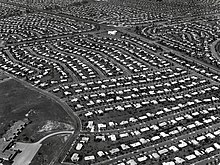Levittown

Levittown is the name of seven large suburban housing developments created in the United States by William J. Levitt and his company Levitt & Sons. Built after World War II for returning veterans and their new families, the communities offered attractive alternatives to cramped central city locations and apartments. The Veterans Administration and the Federal Housing Administration (FHA) guaranteed builders that qualified veterans could buy housing for a fraction of rental costs.
Levitt refused to sell Levittown homes to people of color, and the FHA, upon authorizing loans for the construction of Levittown, included racial covenants in each deed, making Levittown a segregated community.[1]
Production was modeled on assembly lines in 27 steps with construction workers trained to perform one step. A house could be built in one day when effectively scheduled. This enabled quick and economical production of similar or identical homes with rapid recovery of costs. Standard Levittown houses included a white picket fence, green lawns, and modern appliances. Sales in the original Levittown began in March 1947. 1,400 homes were purchased during the first three hours.
Places[edit]
- Levittown, New York - the first Levittown (built 1947–1951)
- Levittown, Pennsylvania - the second Levittown (1952–1958)
- Willingboro Township, New Jersey - originally and colloquially known as Levittown (started 1958)
- Levittown, Puerto Rico (1963)
- Bowie, Maryland (1964)
- Crofton, Maryland (1970)
- Largo, Maryland (1963)
References[edit]
- ^ Rothstein, Richard (May 2, 2017). The Color of Law: A Forgotten History of How Our Government Segregated America. Liveright. pp. 82–83. ISBN 978-1-63149-286-0.
| This article relating to urban planning is a stub. You can help Wikipedia by expanding it. |
No comments:
Post a Comment